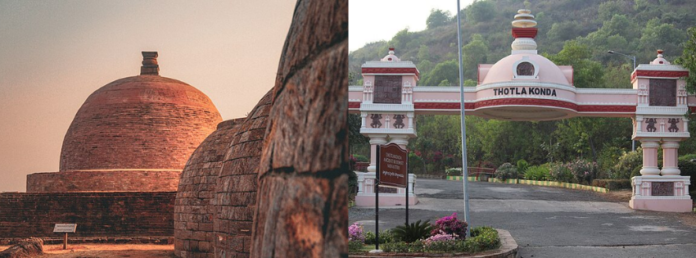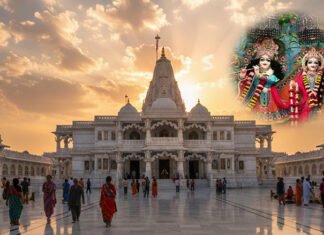Introduction:
Perched on a hill near Bheemunipatnam, approximately 15 kilometers (9.3 miles) from Visakhapatnam in Andhra Pradesh, India, the Thotlakonda Buddhist Complex offers a fascinating window into ancient Buddhist history. The hill rises 128 meters (420 feet) above sea level and overlooks the serene coastline. Its name, derived from the Telugu word “Thotlakonda,” refers to the rock-cut cisterns carved into the bedrock of the hillock. Thotlakonda’s strategic location and historical significance make it a captivating destination for history enthusiasts and cultural explorers.
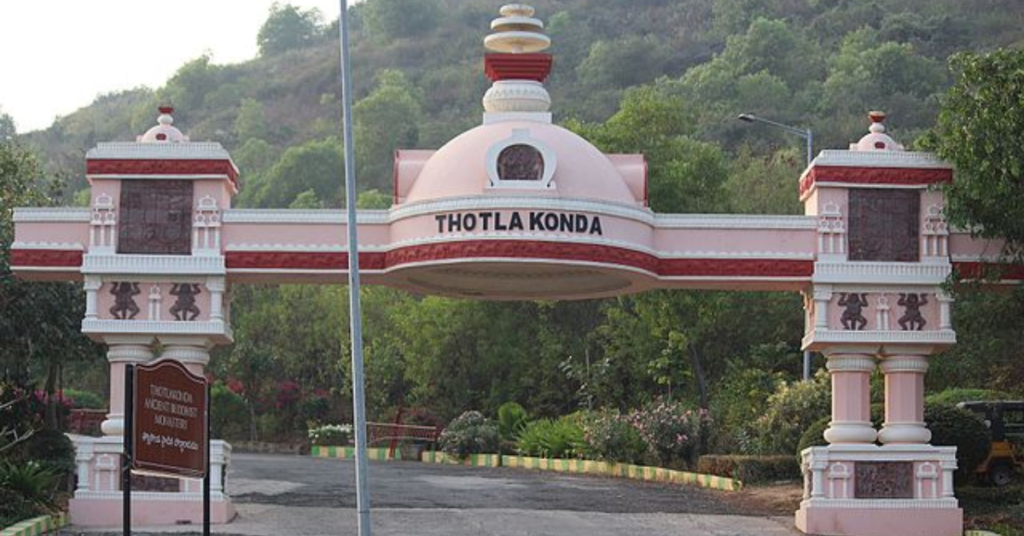
Historical Significance:
Thotlakonda was situated within the influence of ancient Kalinga, a region renowned for its role in spreading Buddhism to Sri Lanka and various parts of Southeast Asia. This hilltop site provided an ideal setting for Buddhist monks to establish a monastery, thanks to its salubrious climate and proximity to the sea. The haven provided by the sheltered coastline also made it a favorable spot for anchoring ships.
The complex came to light during an aerial survey by the Indian Navy in the late 1980s, as they were exploring locations for a potential naval base. Subsequent excavations conducted by the Andhra Pradesh State Archaeology Department from 1988 to 1993 revealed a Hinayana Buddhist complex that thrived around 2000 years ago. The excavations unearthed significant artifacts, including Satavahana dynasty lead and Roman silver coins, terracotta tiles, stucco decorative pieces, sculptured panels, miniature stupa models in stone, and Buddha footprints. Additionally, twelve inscriptions in the Brahmi script were discovered, shedding light on the site’s historical and cultural context.
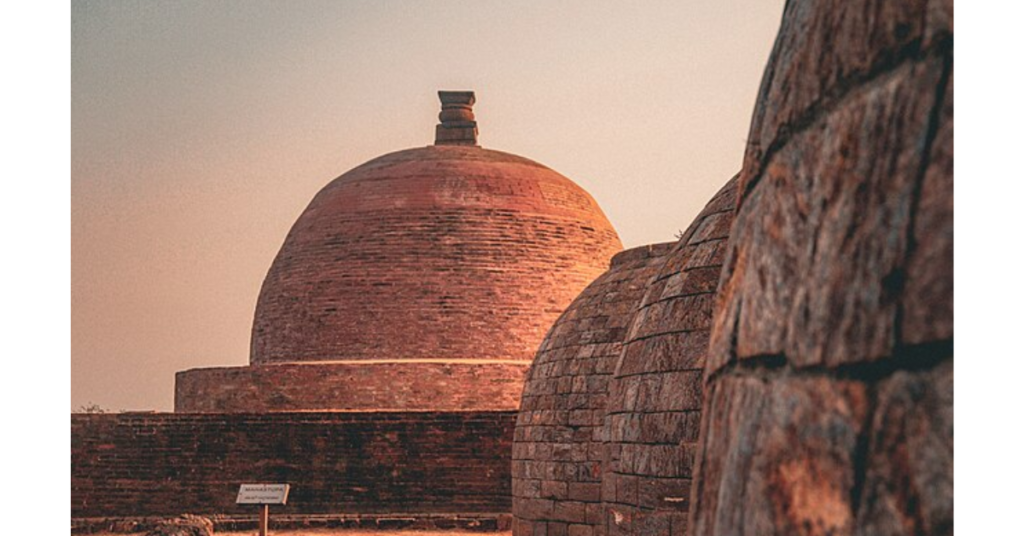
Also Know About: The Submarine Museum: An Ultimate Dive into Naval History
Architectural and Cultural Insights:
Thotlakonda’s peak activity spanned from the 2nd century BC to the 2nd century AD, a period marked by vigorous Roman trade and international religious missions. The site is associated with other ancient locations in Visakhapatnam, such as Bavikonda and Pavurallakonda. The complex featured lofty stupas adorned with light lime plaster, which were illuminated by rows of wick lamps at night, possibly serving as navigational landmarks for maritime travelers.
The monastery likely accommodated over 100 bhikkhus during its prime. The complex stored food, clothing, and medicines, serving as both a religious and academic center. The practice of Nikaya Buddhism was prevalent here, characterized by the worship of Gautama Buddha through symbols such as padukas, rather than human representations.
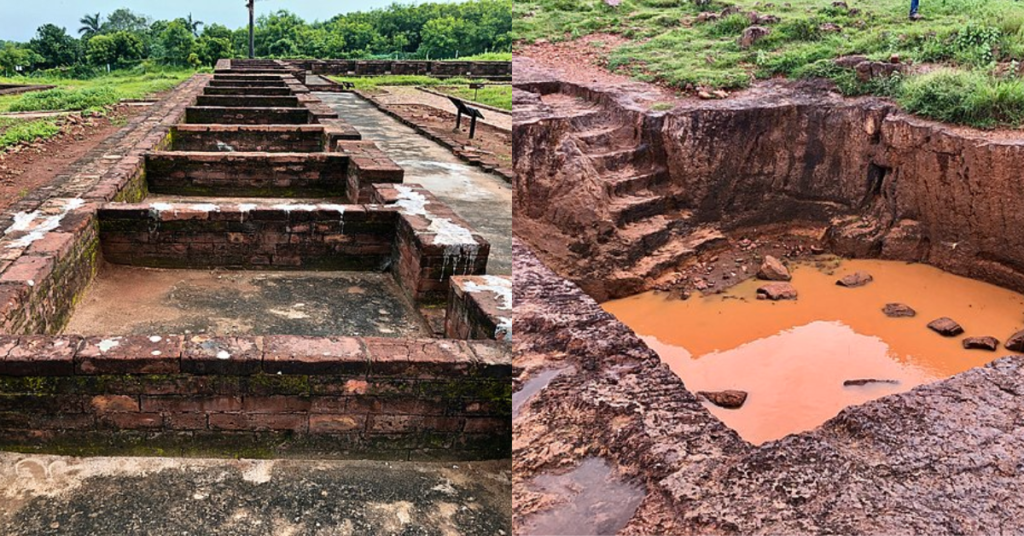
Also read: A Complete Guide to Kambalakonda Wildlife Sanctuary
Visiting Information of Thotlakonda:
For those interested in exploring this historical gem, here is some practical information:
Entry Fee:
- Film shooting/TV Serials: ₹6000 + 18% GST
- Pedestrian Entry: ₹5
Parking Fee:
- Two-wheelers: ₹20
- Cars: ₹30
- Big Bus: ₹300
- Mini Bus: ₹150
- Adult and Child Walkers: ₹5
Nearby Attractions:
In addition to exploring Thotlakonda, visitors can enjoy several nearby attractions:
- Ramakrishna Beach (RK Beach): A beautiful stretch of sand perfect for a relaxing stroll.
- Borra Caves: Stunning limestone caves known for their impressive stalactites and stalagmites.
- VUDA Park: A family-friendly park with boating options and a musical fountain.
- Kailasagiri: A hilltop park offering panoramic views of Visakhapatnam and the sea.
- Mudasarlova Park: Mudasarlova Park is a scenic urban park in Visakhapatnam, featuring lush greenery, a reservoir, and recreational facilities perfect for picnics and family outings.
Conclusion:
The Thotlakonda Buddhist Complex stands as a testament to the rich historical and cultural heritage of ancient India. Its serene location, significant archaeological finds, and architectural marvels provide a profound understanding of early Buddhist practices and the diffusion of Indic culture. Whether you are a history buff, a cultural explorer, or simply curious about ancient civilizations, Thotlakonda offers an enriching and memorable experience.
Frequently Asked Questions(FAQS):
Q1. What is the significance of Thotlakonda Buddhist Complex?
Answer: Thotlakonda Buddhist Complex is a significant archaeological site in Visakhapatnam, India, offering insights into ancient Buddhist practices and trade routes.
Q2. When was Thotlakonda Buddhist Complex discovered?
Answer: The complex was discovered in the late 1980s during an aerial survey by the Indian Navy.
Q3. What are the main attractions at Thotlakonda Buddhist Complex?
Answer: The main attractions at Thotlakonda include the rock-cut cisterns, stupas, Buddha footprints, and ancient inscriptions.
Q4. How can I reach Thotlakonda Buddhist Complex?
Answer: You can reach the Thotlakonda Buddhist Complex by road or by taking a boat ride from Visakhapatnam.
Q5. What is the best time to visit Thotlakonda Buddhist Complex?
Answer: The best time to visit Thotlakonda is during the winter months (October to February) when the weather is pleasant.

